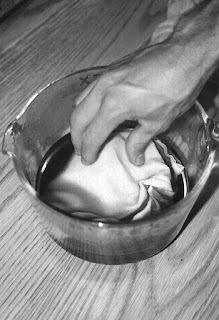In the hay fever article - part I, I promised to tell you how to make an herbal compress. This information for a basic compress is a revised excerpt from my book, "Herbal Medicine From the Heart of the Earth" on p. 371-372 where I explain how to make a simple compress as well as alternating hot and cold compresses and herbal oil compresses.
What a compress is, and how to make it
 A compress or fomentation is simple to make and use. It is a cloth soaked in hot or cold water, or other fluids such as herb tea, herbal vinegar or herbal oil and applied to the skin. It is truly as simple as that. Medicated pads used for hemorrhoids are a commonly used type of compress that is available pre-made and sold in pharmacies. To make a simple herbal tea compress, use a strong herbal infusion or decoction. Make enough tea to soak the cloth thoroughly. To learn how to make a proper herbal infusion or decoction visit "Making Herbal Tea" and for additional information, "Herbal Tea Making Tips"
A compress or fomentation is simple to make and use. It is a cloth soaked in hot or cold water, or other fluids such as herb tea, herbal vinegar or herbal oil and applied to the skin. It is truly as simple as that. Medicated pads used for hemorrhoids are a commonly used type of compress that is available pre-made and sold in pharmacies. To make a simple herbal tea compress, use a strong herbal infusion or decoction. Make enough tea to soak the cloth thoroughly. To learn how to make a proper herbal infusion or decoction visit "Making Herbal Tea" and for additional information, "Herbal Tea Making Tips"
How to use it
The compress is applied to the affected area. If a compress is to be used hot, place a hot water bottle over the compress, once it is in place. Then place a towel or blanket over the entire area. Plastic or towels can be used as a protective barrier between the compress and clothes or bedding. Sometimes a compress is used cool or cold such as in the case of congested, irritated eyes that accompany hay fever. In this case, you need to cool the tea down before using it.
What a compress can do
 The heat from a hot compress relaxes tight muscles and vasodilates the blood vessels in the skin, drawing blood externally to the skin. This can decrease internal congestion and ease the pain of sore muscles, as well as benefit the skin locally. Since cold compresses act to constrict blood vessels in the skin and shunt the blood internally, they are useful for acute burns, bruises and inflammation. An herbal vinegar is sometimes used as an alternative to a tea. Diluted apple cider vinegar is astringing and can be used as an astringent compress in some conditions. The addition of astringent herbs, such as oak, witch hazel or geranium, to a vinegar will create a wonderful compress to use to treat bug bites, stings, hives or poison oak rashes.
The heat from a hot compress relaxes tight muscles and vasodilates the blood vessels in the skin, drawing blood externally to the skin. This can decrease internal congestion and ease the pain of sore muscles, as well as benefit the skin locally. Since cold compresses act to constrict blood vessels in the skin and shunt the blood internally, they are useful for acute burns, bruises and inflammation. An herbal vinegar is sometimes used as an alternative to a tea. Diluted apple cider vinegar is astringing and can be used as an astringent compress in some conditions. The addition of astringent herbs, such as oak, witch hazel or geranium, to a vinegar will create a wonderful compress to use to treat bug bites, stings, hives or poison oak rashes. Using alternating hot and cold compresses will significantly increase the circulation to the area where the compresses are applied. The hot water increases vasodilation, bringing blood to the area, while the cold water increases vasoconstriction, shunting blood away. An analogy to this action is soaking a sponge in water and then squeezing the water from the sponge. The area is bathed in new blood, bringing in new nutrients, while the old blood and lymph are shunted away, carrying waste products with them. See page 372 of the book "Herbal Medicine From the Heart of the Earth" for directions on alternating hot and cold compresses.
Using alternating hot and cold compresses will significantly increase the circulation to the area where the compresses are applied. The hot water increases vasodilation, bringing blood to the area, while the cold water increases vasoconstriction, shunting blood away. An analogy to this action is soaking a sponge in water and then squeezing the water from the sponge. The area is bathed in new blood, bringing in new nutrients, while the old blood and lymph are shunted away, carrying waste products with them. See page 372 of the book "Herbal Medicine From the Heart of the Earth" for directions on alternating hot and cold compresses.
A cold compress made with an astringent herb is often used for inflamed eyes accompanying hay fever. As I mentioned in the previous blog, one of my favorite astringent herbs is geranium root. Any astringent herb can be used as long as it will not cause irritation to the sensitive skin around the eyes .
